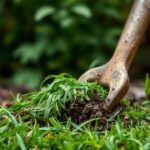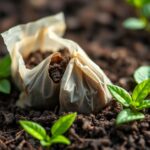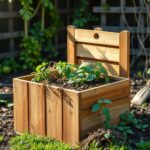Can You Make Compost with Just Grass and Leaves? A Complete Guide to Effective Composting

Composting is an environmentally friendly practice that transforms organic waste into nutrient-rich soil. Many homeowners wonder if they can create compost using just grass clippings and leaves, two common yard wastes. This article provides a comprehensive guide to effective composting using these materials, exploring their benefits, proper ratios, and essential techniques to optimize decomposition. By understanding the science behind composting and how to balance carbon and nitrogen levels, you can turn your grass and leaves into a valuable resource for your garden. Discover the steps to successful composting and unlock the potential of your yard waste.
Can You Make Compost with Just Grass and Leaves?
Yes, you can create compost using just grass and leaves, but there are important factors to consider for it to be effective. Grass clippings are rich in nitrogen, making them a great activator for the composting process. Leaves, on the other hand, provide a source of carbon. When combined, they create a balanced carbon-to-nitrogen ratio, which is essential for successful composting. However, using only grass and leaves may lead to issues like compacting, which can inhibit airflow and slow down decomposition. To optimize your compost, it's beneficial to mix in other materials like kitchen scraps or soil to enhance diversity and promote better microbial activity.
Benefits of Composting Grass and Leaves
Composting grass and leaves offers numerous benefits, such as reducing yard waste and creating a nutrient-rich soil amendment for your garden. Grass clippings add nitrogen, which encourages plant growth, while leaves contribute essential minerals and organic matter that improve soil structure. Additionally, homemade compost can enhance soil's moisture retention, reduce the need for chemical fertilizers, and promote a healthier ecosystem in your garden.
Challenges of Using Only Grass and Leaves
While composting grass and leaves is possible, there are some challenges. The main issue arises when too much grass is added, which can lead to odor problems and create a slimy pile that is less effective in breaking down. Leaves, when used alone, can become compacted and create a barrier that prevents airflow, slowing down the composting process. Therefore, finding a balance and properly managing your pile is crucial for optimal results.
Best Practices for Composting Grass and Leaves
To successfully compost grass and leaves, it is recommended to alternate layers of each material rather than mixing them together. This helps maintain an effective aeration level within the pile. Shredding leaves can also improve the speed of decomposition, as smaller pieces break down faster. Keeping your compost pile moist but not soggy is another best practice, as it encourages microbial activity while preventing odor issues.
See also:
Additional Materials to Enhance Compost
Incorporating additional materials can significantly improve the quality of your compost. Kitchen scraps such as fruit and vegetable peels, coffee grounds, and eggshells can add valuable nutrients. Small branches or twigs can enhance aeration, while paper products like cardboard can provide carbon. A diverse mix of materials allows for a more balanced composting process and helps create a richer final product.
How Long Does It Take to Compost Grass and Leaves?
The time it takes to compost grass and leaves can vary greatly depending on factors such as moisture, temperature, and the materials' texture. Generally, a well-maintained compost pile can take anywhere from 2 to 6 months to break down completely. Regular turning of the pile can speed up the process by increasing oxygenation and promoting microbial growth, leading to faster decomposition of the grass and leaves.
| Material | Carbon Content | Nitrogen Content |
|---|---|---|
| Grass Clippings | Low | High |
| Leaves | High | Low |
| Kitchen Scraps | Varies | Varies |
| Paper/Cardboard | High | Low |
Understanding the Role of Carbon and Nitrogen in Composting
When composting grass and leaves, it is crucial to understand the balance of carbon and nitrogen these materials provide. Grass typically has a higher nitrogen content, while leaves are rich in carbon, creating a perfect ratio for effective composting when combined. This balance is essential for the microbial activity that breaks down the organic matter, ensuring a faster and more successful composting process. By maintaining an appropriate mix, composters can achieve a nutrient-rich end product that benefits garden soil.
The Importance of Browns and Greens in Composting
In composting, organic materials are categorized into browns (high in carbon) and greens (high in nitrogen). Leaves fall into the brown category, contributing essential carbon, while grass clippings are classified as greens, providing nitrogen. Successful compost requires an appropriate mix of both types, ideally in a 3:1 ratio of browns to greens, to promote healthy decomposition and prevent issues such as foul odors or mold growth.
How to Properly Layer Grass and Leaves for Composting
Proper layering is essential for effective composting. Begin by placing a layer of leaves at the bottom of your compost pile, as they help create airflow. Then, add a layer of grass clippings, followed by more leaves. Continue this layering until the pile reaches a significant height. This method not only enhances aeration but also aids in maintaining moisture levels, which are crucial for the breakdown of organic material.
See also:
Common Composting Mistakes to Avoid
Many beginners make several common mistakes when composting with grass and leaves. One prevalent issue is adding too much grass, resulting in a soggy, compacted pile that stifles aeration. Another mistake is neglecting to turn the compost regularly; this is essential for facilitating microbial activity and ensuring even decomposition. Finally, failing to maintain the right moisture level can hinder the composting process, so it’s vital to monitor and adjust as needed.
Optimizing Your Compost Pile with Additives
To enhance the quality and speed of your compost decomposition, consider adding natural additives. Items like coffee grounds, egg shells, or even small amounts of manure can introduce beneficial nutrients and microorganisms to your compost pile. Such additives can balance nitrogen and carbon levels, speeding up the breakdown of grass and leaves and improving the overall soil fertility of your finished compost.
Applications of Finished Compost from Grass and Leaves
Once your compost is finished, the nutrient-rich product can be used in various gardening applications. It serves as an excellent soil amendment, improving soil texture and enhancing its ability to retain moisture and nutrients. Additionally, finished compost from grass and leaves can be used as a top dressing for existing gardens, feeding plants and encouraging healthy growth throughout the growing season.
Questions from Our Readers
Can you make compost with just grass and leaves?
Yes, you can make compost with just grass and leaves, but it's important to ensure a balanced mixture. Grass clippings are rich in nitrogen, while leaves provide carbon. To create effective compost, aim for a ratio of nitrogen to carbon; a mix of both will help with microbial activity and ensure proper decomposition.
What is the ideal ratio of grass to leaves for composting?
The ideal ratio is generally around 1 part grass to 3 parts leaves. This ratio helps maintain a balance between nitrogen and carbon, which is essential for efficient composting. If you add too much grass, the compost can become too wet and smelly, while too many leaves can slow down the process due to their high carbon content.
See also:
How long does it take for grass and leaves to decompose into compost?
The decomposition process can take anywhere from several weeks to a few months, depending on factors like moisture, temperature, and aeration. Regularly turning the compost pile can speed up the process, promoting a more uniform decomposition of your grass and leaves and creating nutrient-rich compost more quickly.
Can I include other materials with grass and leaves in my compost?
Absolutely, you can include other materials like kitchen scraps, small branches, and shredded paper to enhance your compost mix. Just remember to maintain the nitrogen-carbon balance and avoid adding any meat or dairy products, as these can attract pests and cause odor issues. Mixing in a variety of materials will help improve the overall quality of your compost.

If you want to read more articles like Can You Make Compost with Just Grass and Leaves? A Complete Guide to Effective Composting, we recommend you check out our Compost category.
Leave a Reply
Related Articles